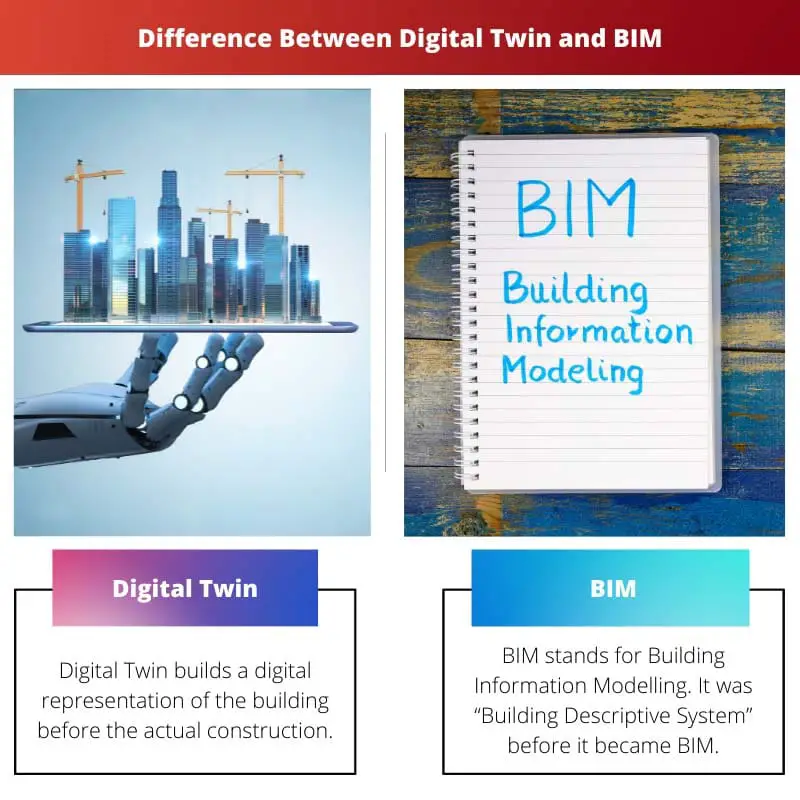Advances in digital layout equipment, inter-connectedness, and laptop-controlled fabrication converge to transform each layout phase and build manner. BIM is a young technology.
There has been confusion in the long term about how Digital Twin differentiates from BIM. BIM is prescriptive, and Digital Twins are descriptive. This article highlights key differences between Digital Twin and BIM.
Key Takeaways
- Digital Twin is a virtual replica of a physical asset, while BIM (Building Information Modeling) is a digital representation of a building’s physical and functional characteristics.
- Digital Twin focuses on real-time data and simulations, while BIM focuses on building design, construction, and maintenance.
- Digital Twin is used to optimizing a physical asset’s performance, while BIM is used to improve the efficiency of the building process and maintenance.
Digital Twin vs BIM
Digital Twin is a virtual representation of a physical object, system, or process that enables real-time monitoring, simulation, and analysis. BIM (Building Information Modeling) is a digital representation of a building’s physical and functional characteristics that helps in planning, design, construction, and management. BIM is a subset of Digital Twin, as BIM models can be used to create Digital Twins.

The Digital Twin is the representation of a building as digital data. Digital Twin gives detailed information about the current state of build subsystems.
The next evolution of the Digital Twin will require people, processes, and behaviours as important data sources. The applications of the Digital Industry lie primarily in the manufacturing industry. The examples are:
- Product Development
- Design Customisation
- Aerospace
- Automotive
BIM is the digital replica of design and construction. It makes it easier for the team and the stakeholders to visualize how the building will look like.
It shows the detail per level, like Level 1 BIM, Level 2 BIM and many more. The examples which prove what BIM can do are:
- Crossrail
- Istanbul New Airport
- Baku National Stadium
Comparison Table
| Parameters of Comparison | Digital Twin | BIM |
|---|---|---|
| Definition | Digital representation of a building with the interaction of people. | Digital view of Design and construction. |
| Benefits | Predicts potential failures and prevents severe accidents and damages. | Project management and risk analysis |
| Simulation of operations | Real-time operational response | No real-time synchronization |
| Prediction of data | Predicts data about weather forecasts, energy demand, etc. | No prediction can be made. Only accuracy and completeness can be understood. |
What is Digital Twin?
Digital Twin builds a digital representation of the building before the actual construction, which helps the stakeholders to visualize the whole project and helps the team members to make better design decisions.
This technology has increased with the rise of new technologies. This technology is also termed “Cyber-physical integration”.
The digital twin is to gather data and use physics simulations to create a live model replicating the real world. This can be used in several ways, from fault detection to maintenance planning.
It represents a building in use, replacing assumptions with definite values, and responds in real-time. This aims to provide the data more precisely, effectively, and innovatively.
The three main pillars of Digital Twin are:
- Physical Entity
- Digital Thread
- Virtual Model
Digital Twin is useful for building modifications, operation, and facility maintenance even after project completion. The beneficiaries of the digital twin are facility managers, architects, engineers, developers, builders, and owners.
This technology enables the team to visualize the real-time performance of the building, which helps them optimise its efficiency.
This technology saves a lot of time, costs, and expensive shutdowns. The data extracted is highly accurate for it to conduct clash detection, costing, and construction simulation.

What is BIM?
BIM stands for Building Information Modelling. It was a “Building Descriptive System” before it became BIM. This allows all the professionals to plan, design, and construct the structure of the building within one 3D model.
BIM is to replicate the physical asset along with its properties as per the level of detail. BIM is a 3D model process that generates the design documentation for construction. This is used in the industry to elaborate the design options and create visualizations that help the stakeholders understand how the building will look.
BIM objects that create BIM models have geometry and store data. If there are changes in BIM software, it updates the model to reflect the changes.
BIM gathers all the information about each building component and makes it possible to access. The process of BIM involves planning, designing, building and operating.
B for Building
It refers to designing a building using one coherent system of computer models. BIM does not refer to buildings but all construction-related sectors, including roads, railways, bridges, etc.
I for Information
Information is the main element of BIM. It changes the information regarding the entire life cycle of a project.
M for Modelling
This process of construction is organized and controlled more effectively.

Main Differences Between Digital Twin and BIM
- BIM is used only for collaboration and visualization during design and construction rather than operations and maintenance.
- BIM is not used for creating a live model of an operational building but helps create a collaborative design focusing on the physical and functional aspects.
- BIM is not designed for a real-time operational response.
- Digital Twin keeps updated about the current state of build subsystems.
- People, processes and behaviours are important data sources for Digital Twin.


The comparison table is particularly helpful in highlighting the distinctions between Digital Twin and BIM. It’s a valuable reference for professionals in the field.
Absolutely, having a clear understanding of how these technologies differ is crucial for effective decision-making during construction projects.
This article is an excellent resource for professionals seeking to expand their knowledge of Digital Twin and BIM technologies.
The article provides a clear and insightful comparison between Digital Twin and BIM. It’s essential to understand the differences between these two technologies to make informed decisions in the construction industry.
I agree with you. The explanations are detailed and help in understanding the practical applications of Digital Twin and BIM in construction.